Along with Alan Grant and Denny O’Neil, Ty Templeton is one of the core writers who has defined my platonic ideal of Batman comics. In fact, his work on the Batman Adventures line in the 1990s / early 2000s is so pitch-perfect that, for years, I’ve been struggling with how to approach a post on Templeton other than to say ‘This is how Batman stories are done. Everything else are more or less interesting departures and variations.’
Below, you’ll find my attempt to be a bit more precise.
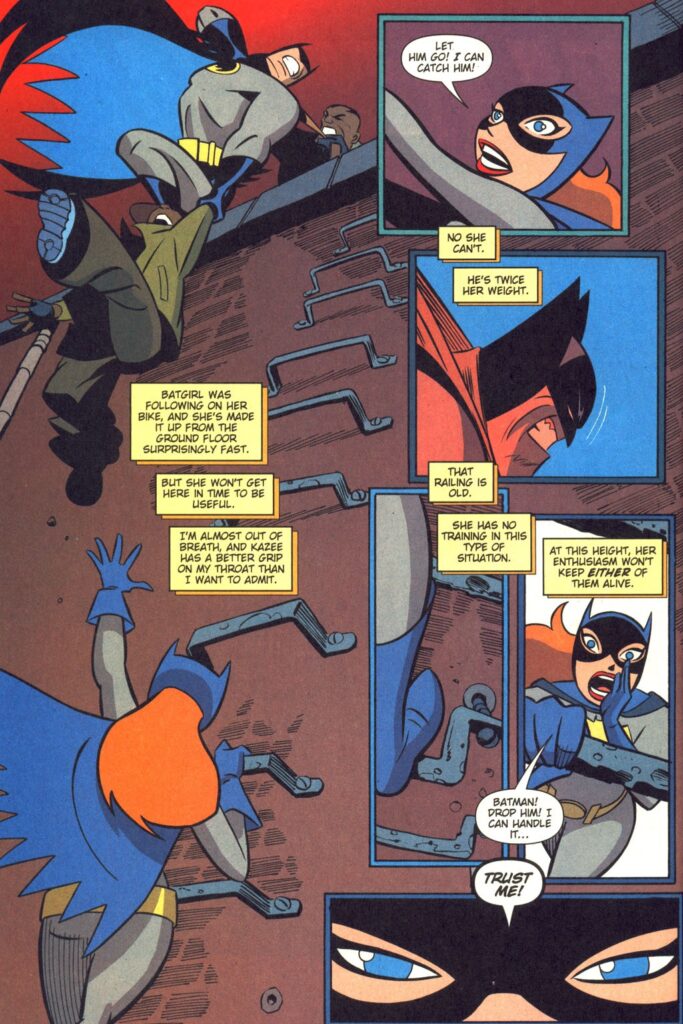
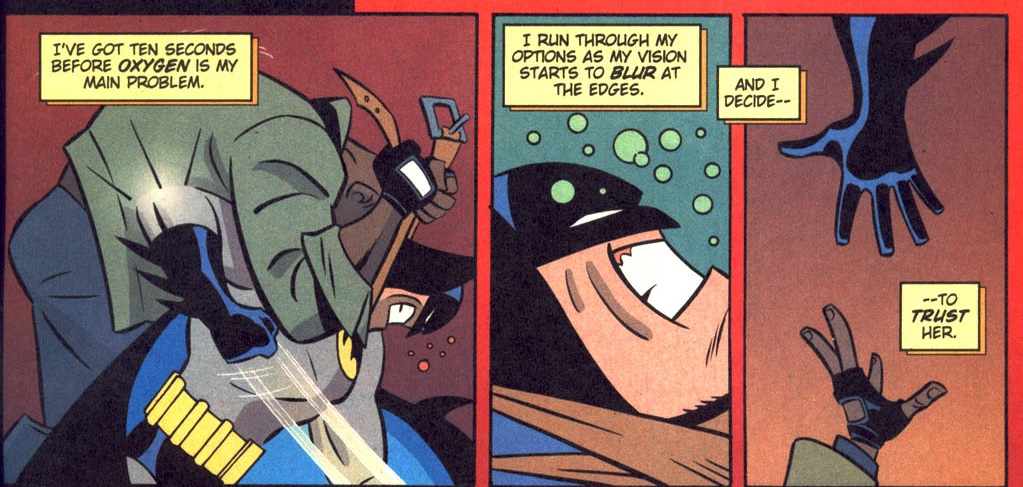
Batman Adventures (v2) #7
The first thing to highlight is that Ty Templeton ‘gets’ Batman himself, namely the necessary balance between the character’s dark side (obsessive traumatized child) and his more compassionate and joyful features (although driven by the desire to protect people, he’s also a rich dude who clearly has a blast playing with his toys). Notice, for instance, how the scene above nails the Caped Crusader’s clear-sided, methodical inner voice, but doesn’t forget to counterbalance his hyper-rational calculations with an emotional dimension.
Indeed, one of the things I most like about Templeton’s take on Batman is that this is a mature, well-adjusted figure (for Gotham City standards) who feels comfortable and confident in what he is. Rather than having him constantly brood or struggle with the temptation of going over the edge, these stories convey the Dark Knight’s painful origin and obsessive behavior through poignant moments and sporadic exchanges succinctly reminding us that all the dress-up, codenames, and gadgets are ultimately ways of coping with the hurt that came from the sudden loss of his parents when he was a kid.
One of the ways Templeton – or, as he sometimes likes to sign, Ty the Guy – handles this is through recurrent allusions to Batman’s traumatic relation with guns:
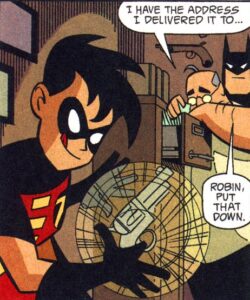
Gotham Adventures #6
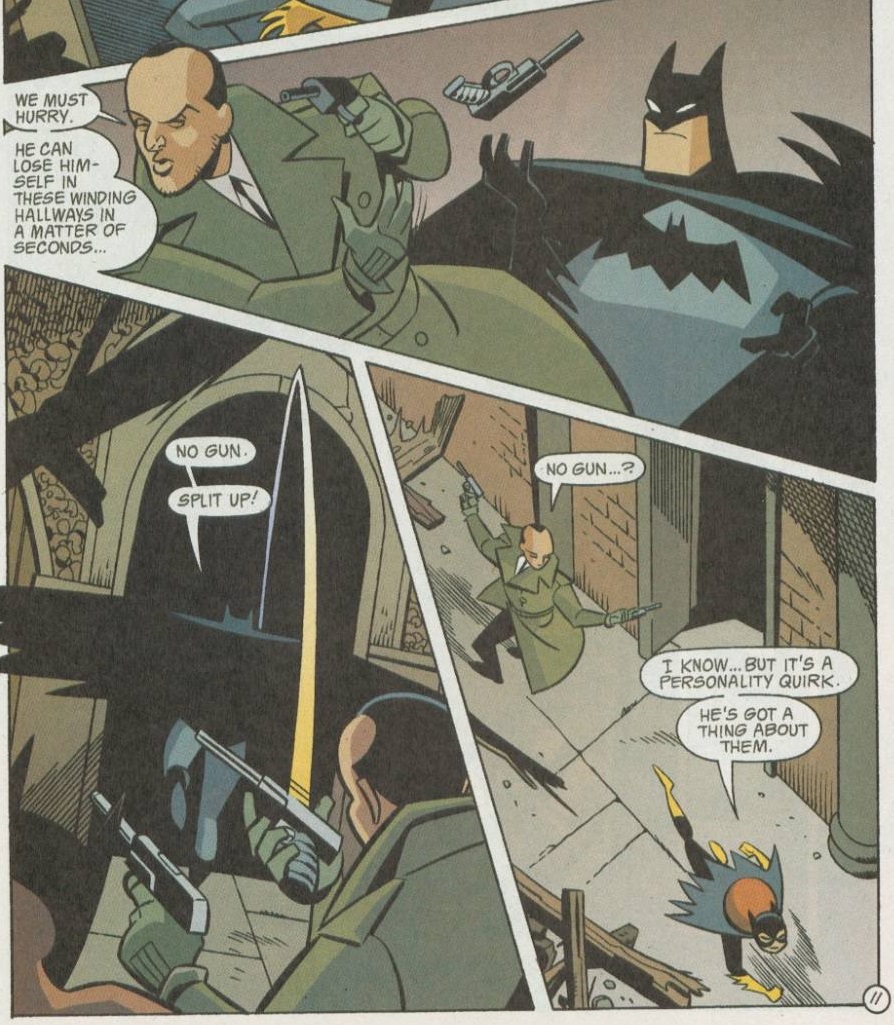
Gotham Adventures #8
Ty Templeton eventually addressed the gun issue head-on, in Gotham Adventures #9, but for the most part it remained a character trait rather than a theme to be explored in detail. These are committedly fun comics about disturbed characters, not the other way around.
Likewise, Templeton seems fully aware that the allure of Batman as a hero is that he’s a vehicle for both visual excitement (he has a cool design, so it’s neat to watch him in action) and cerebral games (he’s the smartest guy in the room, but the thing is that he often has to outsmart criminals operating according to their own bizarre, seemingly irrational logic). The most satisfying stories tend to cleverly merge these two aspects. In ‘Two Minute Warning’ (Batman Adventures (v2) #6), the Caped Crusader is tied to a chair by the Sportsmaster yet totally controls the situation, psychologically manipulating the villain’s crew while setting up the final – sports-themed – fight scene.
A classic strategy to showcase the Dark Knight’s resourcefulness is by placing him in a deathtrap and then having him escape through a combination of intelligence (figuring out a loophole in the trap) and physical prowess. Take, for instance, ‘Birdcage’ (Batman & Robin Adventures #4), where the Penguin – no doubt inspired after a Hitchcock movie night – programs three hundred and thirty-eight birds to recognize Batman’s suit and to violently attack him, bickering him to death…
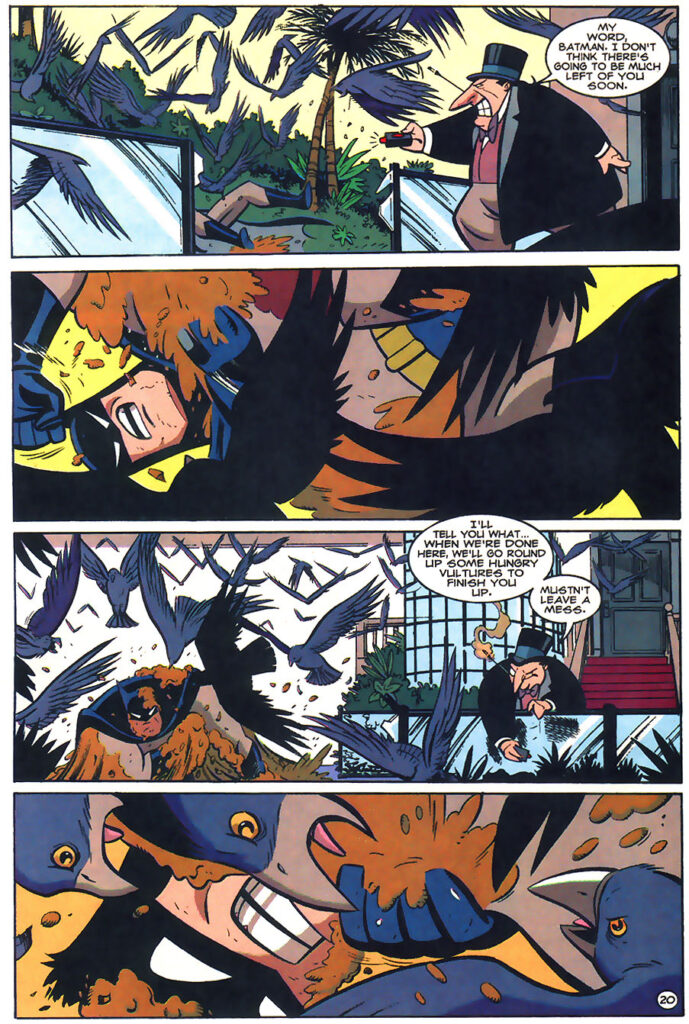
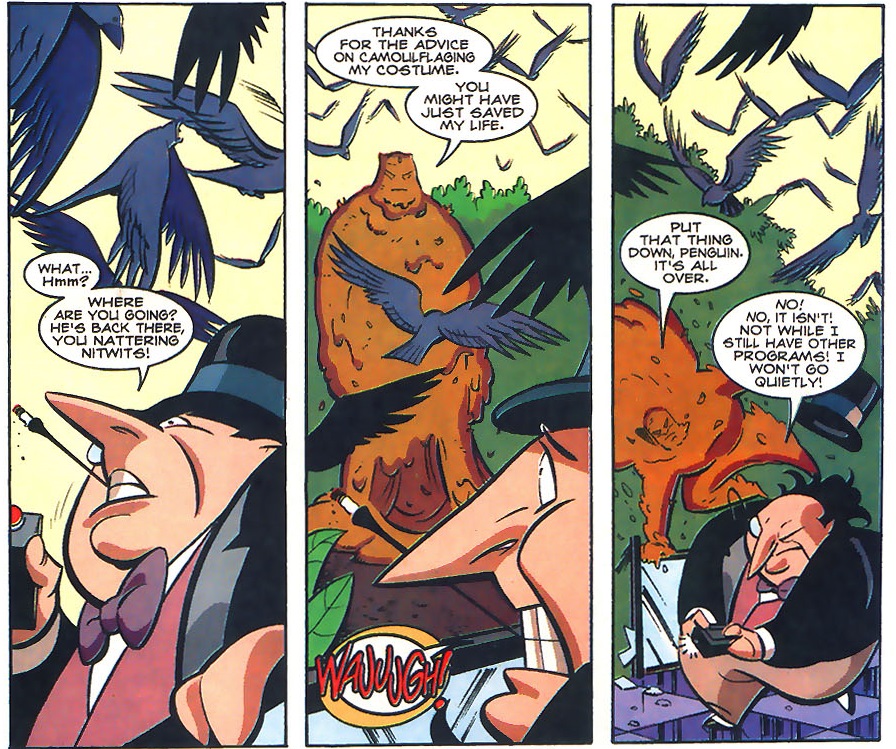
Batman & Robin Adventures #4
It’s a nifty issue all around, complete with an oddball premise (the Penguin tries to release all the birds from the Gotham Zoo because he considers them political prisoners) and a bittersweet final note (the story finishers with the Penguin, back in prison, smiling as he thinks about a toucan’s freedom).
It also brings us to the fact that, besides having a solid take on the Caped Crusader, Ty Templeton also excels at handling the various members of the Rogues’ Gallery. He has a field day magnifying their ludicrous megalomania and delusions, making their irrationality simultaneously laughable and menacing…
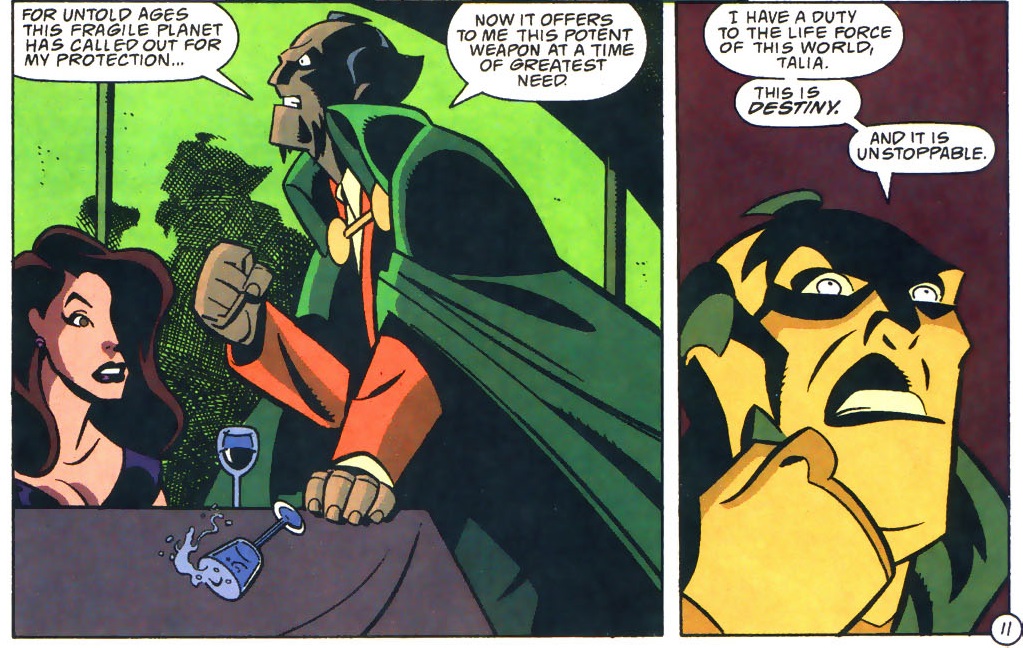
Batman & Robin Adventures #10
Templeton is particularly fond of the Joker, capturing the character’s idiosyncratic combination of cruelty and comedy, like when he had the Clown Prince of Crime trying to beat a guy to death with a bunch of bananas because ‘bananas are funny’ – even while admitting this is not practical at all (‘Boy, it takes forever to kill a guy with bananas. What was I thinking? I should have brought plantains.’).
Or this sinister moment in which the Joker riffs on Roger Rabbit:
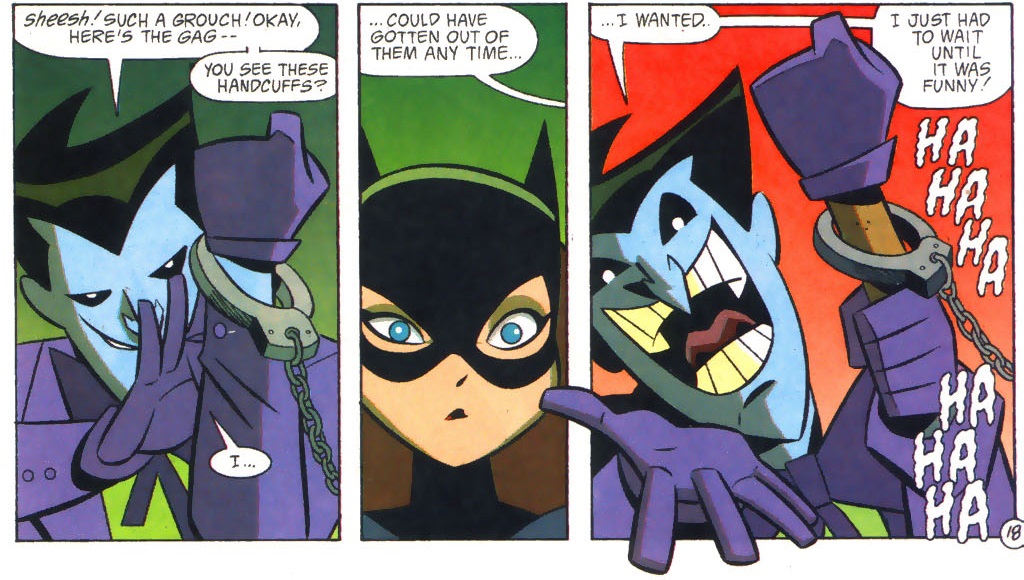
Gotham Adventures #1
Likewise, Templeton keeps going back to the Riddler, which is probably one of the main reasons why Edward Nygma became one of my top rogues. A good Riddler story involves not only amusingly intricate puzzles, but also thinking outside the box, beyond the riddles’ surface, in order to anticipate the villain’s larger plan – and Ty the Guy comes up with plenty of fresh variations on the formula. High points include ‘Why Is a Raven Like a Writing Desk?’ (Batman & Robin Adventures #21), ‘The Oldest One in the Book’ (Gotham Adventures #11), and ‘Poker Face’ (Batman Adventures (v2) #11), all of which would fit in comfortably in any anthology of the greatest Riddler tales of all time.
One of the things I really like is Templeton’s insistence that the Riddler has a subconscious compulsion: Edward Nygma cannot help himself from leaving clues for his opponents (usually through strategic word choices), even when he doesn’t want to. This notion challenges us, the readers, to pay especially close attention to the dialogue in order to pick up clues – and makes the Riddler a villain who sometimes has to fight against himself.
In fact, true to the spirit of Batman: The Animated Series (of which these comics are a spin-off) there tends to be a substantial level of ambiguity – and even empathy – regarding the rogues. ‘Birdcage’ is hardly the only issue to wrap up with a nod towards the villain’s motivations and tragic condition… For instance, while pretty much all confrontations with Man-Bat until the mid-90s had the Dark Knight ‘cure’ the creature in the end (i.e. injecting Kirk Langstrom or whomever had become Man-Bat with a serum that turned them human again), in Batman & Robin Adventures Bruce, for once, respected Kirk’s deliberate choice of continuing to look like a monster.
Thus, overall, these are fairly humanistic comics. One of my favorite issues is ‘Dagger’s Tale’ (Batman & Robin Adventures #14), where prison inmate Charlie ‘Dagger’ Dixon recounts his run-ins with the Dark Knight, humanizing all those nameless petty crooks we usually see only from the other side of the story. I don’t know if the character’s name is a tribute to writer Chuck Dixon, but it may as well be, since the comic is just the kind of stuff Dixon excels at: a one-and-done street-level yarn set in in the underworld of seasoned criminals, told with economic precision and a somewhat hardboiled edge…
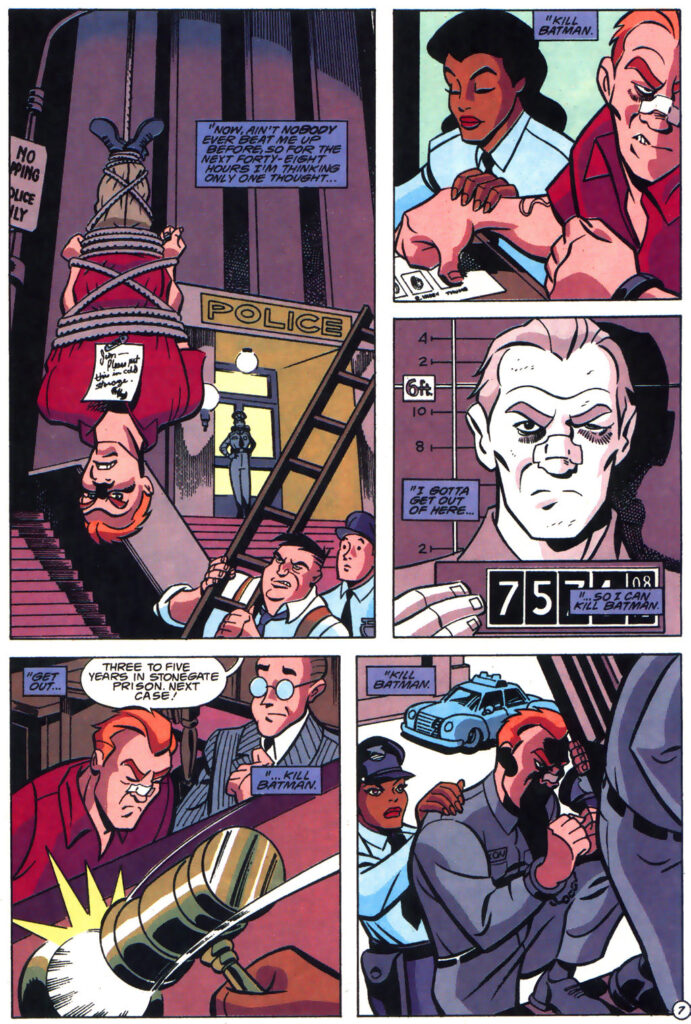
Batman & Robin Adventures #14
Looking back, I now get that almost all issues feature a relatively sympathetic approach to the Dynamic Duo’s antagonists, at some point. I don’t think I fully realized it when I was younger, but I suspect that’s part of what drew me to this material in the first place and why it had such a lasting impact… Underneath the apparently simple world, rendered with deceptively simple artwork, there is a degree of emotional nuance and a recurring acknowledgement that people tend to see themselves as the hero of their own personal stories.
This humanism was taken to a higher level in the final issue of the excellent second volume of Batman Adventures (published in 2003-2004), with a tale devoted to Joe Chill, the man who murdered Thomas and Martha Wayne. In ‘Fear Itself,’ Chill is certainly not presented as a nice guy (this is not a naïve comic) and the issue doesn’t try to downplay or justify his seminal action, but it does enable us to briefly look at the world through his perspective:
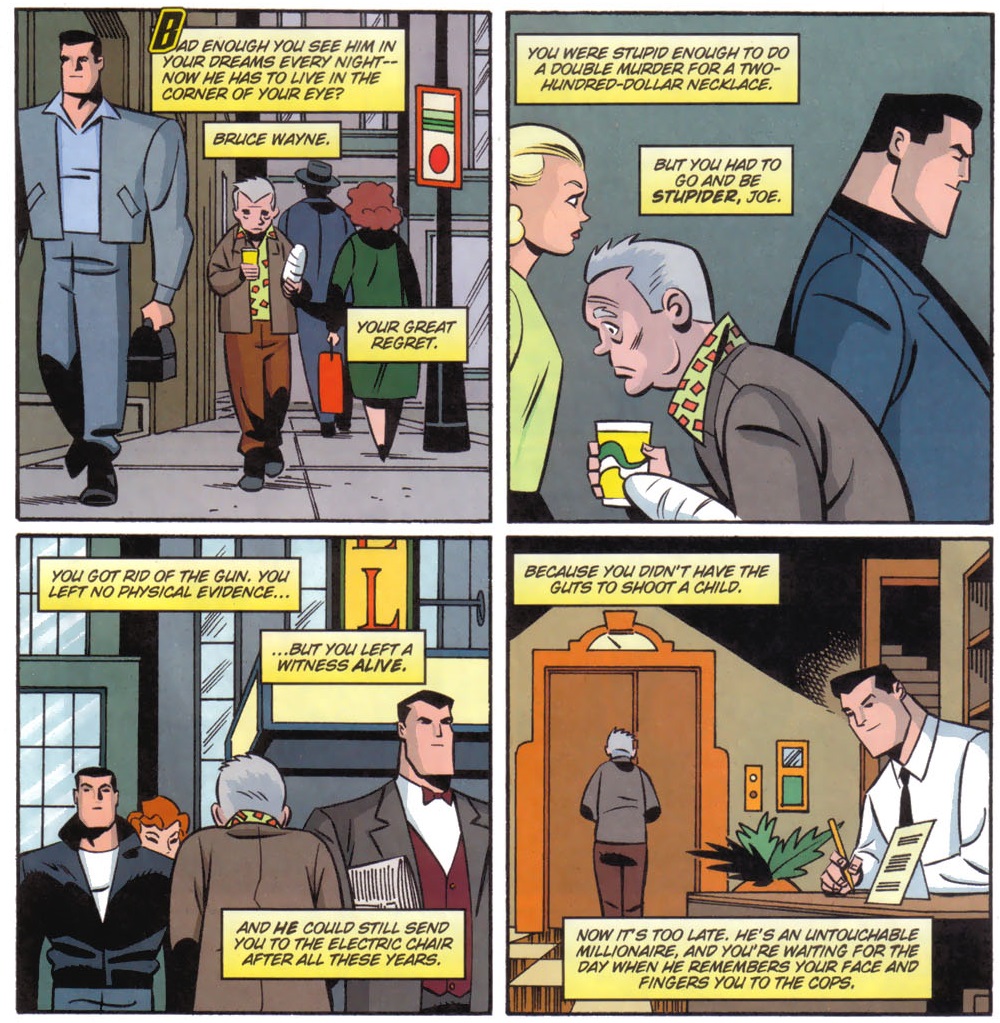
Batman Adventures (v2) #17
Drawing all the men around Joe Chill with the same (minimalistic) built and facial features of Bruce Wayne is such an effective way of visualizing the former robber’s obsessive mindset… We are never explicitly told this is a projection of Chill’s POV, but the comic trusts us to quickly get it – and to subsequently feel how much this old man is haunted by regret and paranoia. Like many of Ty Templeton’s best Batman issues, ‘Fear Itself’ was penciled by Rick Burchett and inked by Terry Beatty, who did a wonderful job, although I assume this visual choice was clearly indicated already in the script (since it pays off in the end).
Perhaps because Templeton is an accomplished artist himself, he has a strong command of the techniques of comic-book storytelling and his scripts seem full of ingenious strategies to keep things visually interesting. Check out, in the page below, how a superficially low-key scene (about Selina ‘Catwoman’ Kyle discussing bribes for local officials in order to protect the last natural refuge of Siberian tigers in Eastern Russia) was rendered in a constantly entertaining fashion:
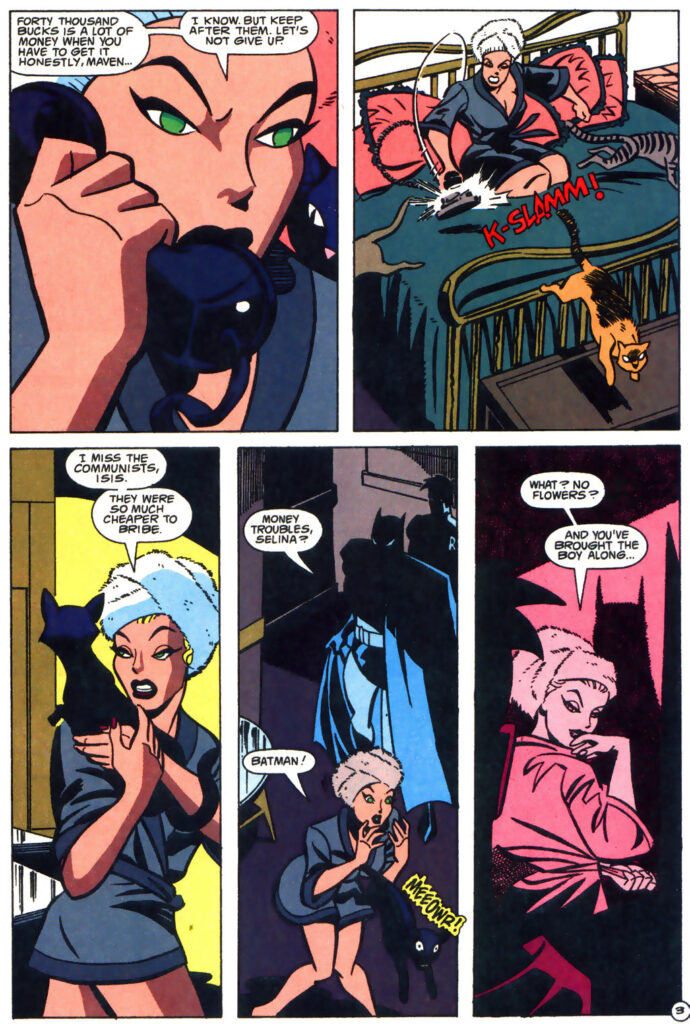
Batman & Robin Adventures #16
There is a joke, no matter how slight, in every single panel: Selina’s sardonic dismissal of honest labour, the way she scares off all the cats with one gesture, her cynical appreciation of the USSR, Batman’s euphemism, Selina’s immediate shift towards her flirtatious Catwoman persona… Likewise, there is a dynamic flow to the artwork – here penciled by Brandon Kruse and inked by Burchett – as the angles keep shifting significantly (close-up, distant framing, medium shot, then we get a perspective from above, followed by a quasi-reversal that veers close to Robin’s POV, placing Selina between the Teen Wonder’s silhouette and the shadow of the Dark Knight) and Catwoman goes through a whole range of body movements and expressions (serious negotiation, angry catharsis, venting in friendly complicity, surprise, and seductive playfulness).
It’s nothing groundbreaking – just sheer craft at its functional best, making every page a delight… This is not to say Templeton and Rick Burchett didn’t occasionally come up with some bolder tactics, like the denouement of ‘His Master’s Voice’ (Batman & Robin Adventures #7), which revolves around a brutal clash between Arnold Wesker’s split personalities: the Ventriloquist and his puppet, Scarface. There, a splash is broken into complementary page-wide horizontal panels, somehow slowing down the pace – and, thus, the touching impact – of Wesker’s devastating revelation:
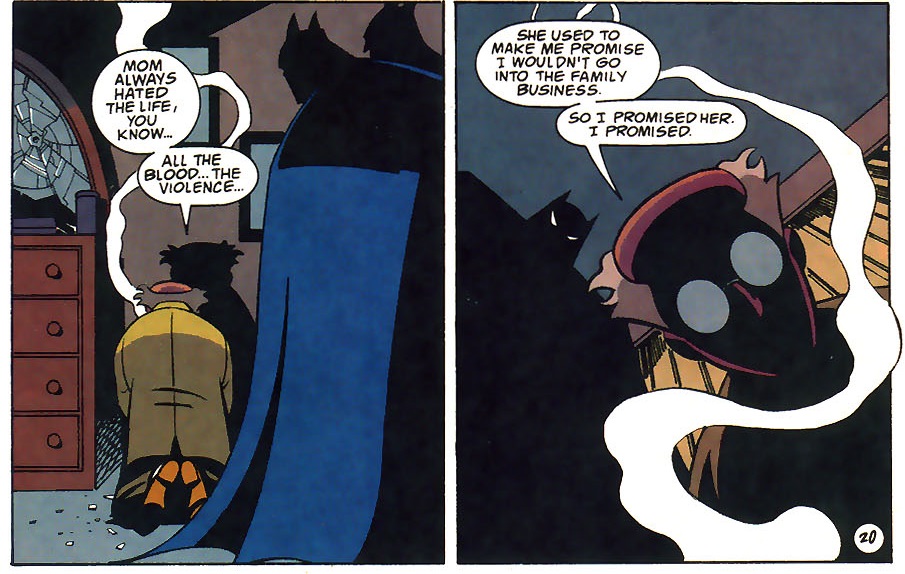
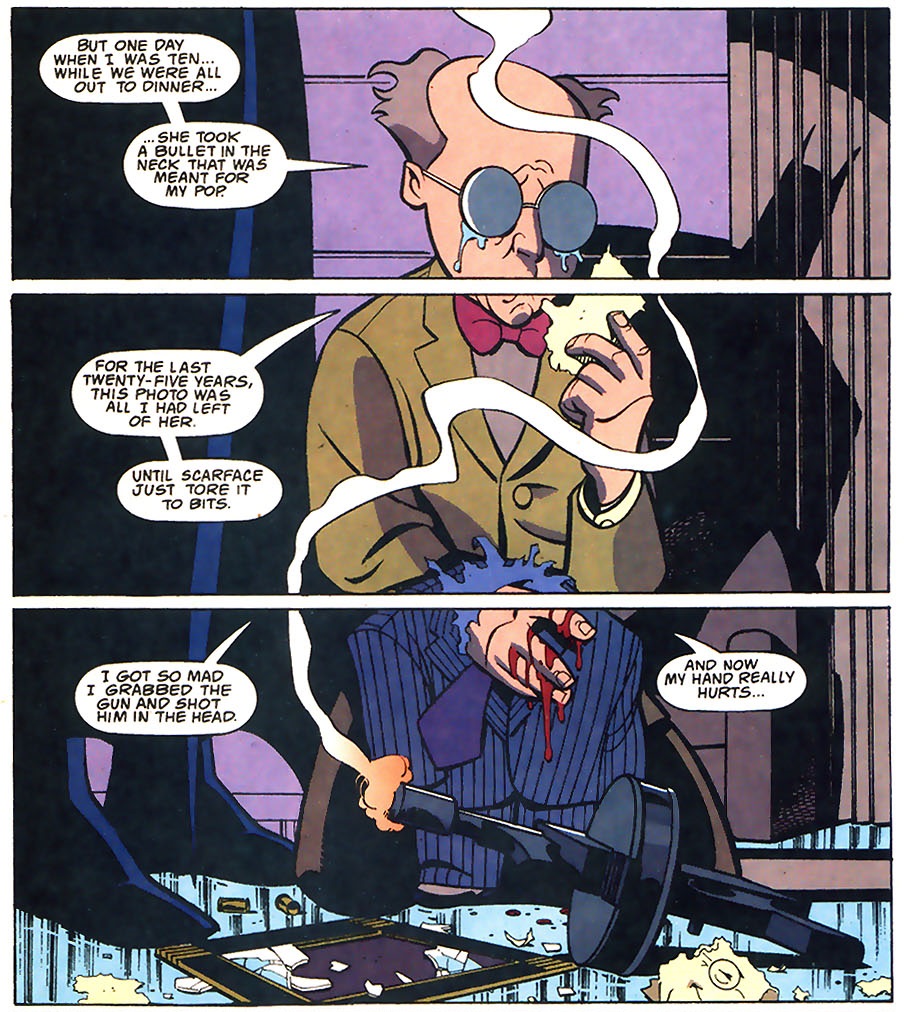
Batman & Robin Adventures #7
Besides the artificial panel borders, the cadence of the Ventriloquist’s monologue is amplified by Tim Harkins’ relatively small speech balloons and sub-balloons, including the distant positioning of the two separate balloons in the bottom panel, which creates a beat before the ‘punchline.’
Indeed, Ty Templeton didn’t just benefit from talented artists who made the most out of the stylized looks inherited from the TV show. The whole creative team was awesome, especially once Lee Loughridge became the regular colorist, often intensifying the stories’ atmosphere through selective monochromatic sequences. Plus, the series were helmed by editor Scott Peterson, who no doubt played a role in bringing together the comic’s overall tone, since he later seamlessly took over from Templeton as writer of Gotham Adventures and the quality didn’t drop a single iota.
Part of the writer-editor partnership involves maximizing the enjoyment that can come out of a book and, whether the choice came from Templeton or whether it was steered by Peterson, one more thing these series have going for them is that they deliver accessible one-and-done tales, which is a format that served Batman comics really well in their first four decades. What’s particularly impressive is that they often manage to have this cake and eat it too: while individual issues read as satisfying self-contained yarns, they also subtly draw on continuity, rewarding the most completist fans.
A few issues are sequels to episodes from the TV series, albeit conveying enough backstory that anyone can pick them up without getting lost. If you go through Gotham Adventures in order, you’ll be able to spot links that form an overarching saga about the League of Assassins, although no chapter is required reading in order get the next one. Another example of working simultaneously with and without continuity, also in Gotham Adventures, are the discreet sequels to some of the best issues Templeton had written in previous series. For instance, ‘Just Another Day,’ ‘Last Chance,’ and ‘Dagger’s Secret’ (Gotham Adventures #3, #6, and #7) expanded the character arcs from ‘Just Another Night,’ ‘Second Chances,’ and ‘Dagger’s Tale’ (The Batman Adventures #33, Batman & Robin Adventures #14 and #15) without exclusively relying on – or even expecting – readers’ familiarity with those other issues: these new tales could be read on their own and they were still great.
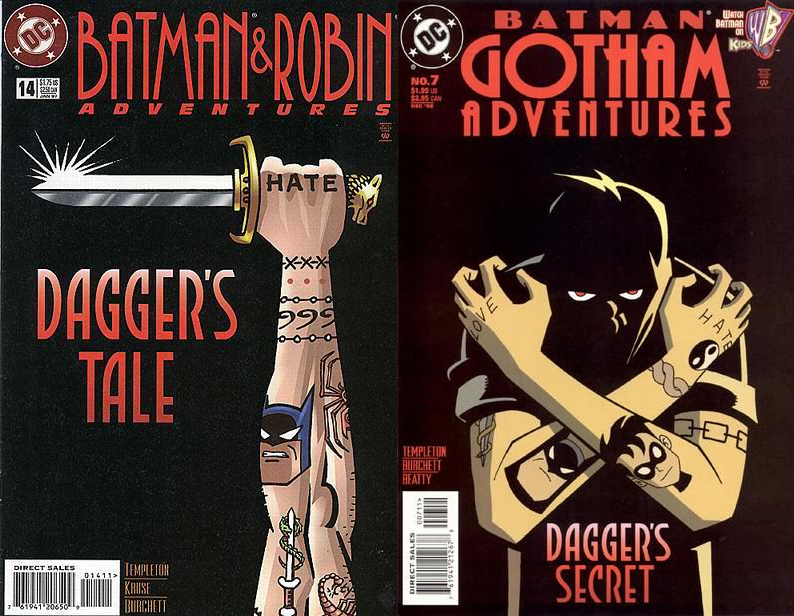
Ty Templeton further flexed his storytelling muscles when he rebooted Batman Adventures in 2003 (now edited by Joan Hilty). This time, the continuity was much tighter from issue to issue, but once again every installment was so packed that they never felt like mere ‘chapters.’ In fact, each issue usually contained two stories, one that Templeton wrote, with art by Rick Burchett, and another one he drew, scripted by Dan Slott (with whom Templeton has frequently collaborated over the years, including as co-writers for the fun Superman Adventures #40 and for an arc of She-Hulk). That run was hands-down one of the high points of whole Batman franchise and it’s a shame it didn’t last more than seventeen issues… As happy as I was to see the return of this iteration of the characters in 2020, with Batman: The Adventures Continue, my excitement was somewhat mitigated by the fact that Templeton is only drawing the new comics, without scripting duties. I would’ve loved to see what he had planned ahead.
Ultimately, regardless of spinning off from an animated show and being ostensibly geared towards younger readers, Templeton’s comics often feel like a ‘purer’ version of Batman’s world than the one in the ‘official’ stories from DC’s core continuity. In other words, I totally get his statement when he first left the book, after almost four years of scripts:
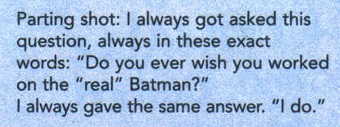
Gotham Adventures #14
